Beeton's Book of Needlework | Instructions and Patterns in Guipure D'Art
INSTRUCTIONS AND PATTERNS IN GUIPURE D'ART
Ancient Guipure was a lace made of thin vellum, covered with gold, silver, or silk thread, and the word Guipure derives its name from the silk when thus twisted round vellum being called by that name. In process of time the use of vellum was discontinued, and a cotton material replaced it. Guipure lace was called intelle à cartisane in England in the sixteenth century. Various modern laces are called Guipure, but the word is misapplied, since Guipure lace is that kind only where one thread is twisted round another thread or another substance, as in the ancient Guipure d'Art.
In every design where lace can be introduced, Guipure d'Art will be found useful. It looks particularly well when mounted upon quilted silk or satin. The squares, when worked finely, look well as toilet-cushions, or, if worked in coarser thread, make admirable couvrettes, and as covers for eider-down silk quilts are very elegant. Guipure squares should be connected by guipure lace, crochet, or tatting, or they may be edged with narrow guipure lace and joined at the corners only when placed over coloured silk or satin; thus arranged, a sofa-cushion appears in alternate squares of plain and lace-covered silk; a ruche of ribbon and fall of lace to correspond completes this pretty mounting.
Not one of the least important attractions of Guipure d'Art is the speed with which it is worked, and the ease with which fresh patterns are designed by skilful workers.
GUIPURE D'ART is an imitation of the celebrated ancient Guipure Lace, and is worked in raised and intersected patterns upon a square network of linen thread, Mecklenburg thread of various sizes being used for this purpose. The needles employed are blunt, and have large eyes, to admit the linen thread.
Materials required: One frame of wire covered with silk ribbon; one square of Mecklenburg thread net (fillet), either coarse or fine; Mecklenburg thread; netting-needles and meshes of various sizes.
The netted foundation, or "fillet," upon which this elegant work is embroidered, can be made by ladies very easily, and at much less cost than when bought ready made.
The square is worked by netting with coarse No. 2 or fine No.10 thread over a mesh measuring three-quarters of an inch or more, in rows backwards and forwards. Begin with 2 stitches, and increase 1 at the end of every row till you have one more stitch than is required for the number of holes. Thus, if a square of 26 holes is required, continue to increase up to 27 stitches, then decrease 1 at the end of every row till 2 stitches only remain. The last 2 stitches are knotted together without forming a fresh stitch.
The completed foundation is laced upon the frame, taking the lacing cotton through the double edge formed by the increased and decreased stitches. If the four corners of the netting are tied at each corner of the frame before beginning the lacing, that operation is greatly facilitated. The netting should be laced as tightly as possible, it being far easier to darn on than when loose.

Ladies who wish to excel in working guipure d'art should practise each of the stitches until they attain perfect regularity and quickness in their execution. Two or three hours devoted to this in the first instance will not be time wasted, as the most elaborate pattern will be worked with ease as soon as the stitches are mastered.
The Mecklenburg thread of Messrs. Walter Evans and Co., of Derby, will be found a better colour than any other, as it closely resembles the shade of the ancient guipure lace.
It is sold only in spools of 200 yards each, and the numbers run as follow; No. 2, 4, 6, 8, lo, 12, 16, 20; No. 2 being the coarsest, and No. 20 the finest.
The principal stitches used in guipure d'art are POINT D'ESPRIT, POINT DE TOILE, POINT DE FESTON, POINT DE REPRISE, POINT DE BRUXELLES, and WHEELS and STARS. POINT D'ESPRIT is worked with finer cotton than the foundation, say No. 10 on a foundation of No. 6. It consists of a succession of small loops, as will be seen clearly in the illustration. The learner should begin from the mark * No. 503, and working a row of loops the length required, turn the frame and work loops on the opposite half of each square intersecting the first worked loops in the centre of each intervening bar of netting. A careful examination of Nos. 503 and 506 will explain this more clearly than is possible in words.

POINT DE TOILE, or LINEN STITCH, is plain darning under and over each thread; this forms a fine close groundwork, and is much used in guipure d'art. Care should be taken to keep the same number of stitches in each square, both along and across; the number of threads shown in illustration No. 504 is 4 only, but 6 and even 8 are used in many netted foundations in fine patterns.
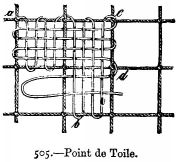
POINT DE FESTON is worked by a series of overcast stitches, as seen by illustration 506, which clearly shows the manner of working. The frame is turned at each stitch, the stitches are taken across the squares, and increase in length at the top of the square.
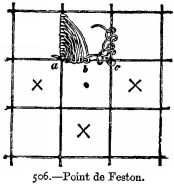
POINT DE REPRISE, or DARNING, is worked by stretching 2 or 3 threads over 1, or 2, or more squares. The thread is darned over and under, and the needle used to arrange the last stitch while passing through to form the next. This stitch is very easily acquired. It is always worked with coarser thread than the foundation; No. 2 thread should be employed for a coarse groundwork. No. 510 shows this stitch used to form stars, figures, &c.
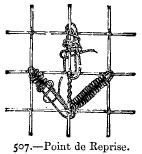
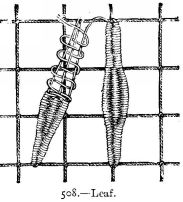
POINT DE BRUXELLES, as shown on pages 506 and 507, is a kind of loose button-hole stitch, and is used for forming various patterns and for filling up squares. It also forms "leaves," when the number of stitches is decreased each row until the leaf finishes off in a point. Nos. 509 and 510 clearly show this stitch.

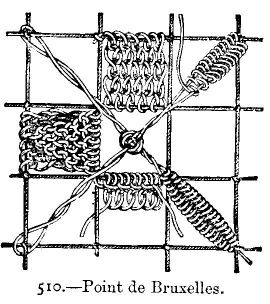
WHEELS are easy to work, and are begun in the centre. Four threads are taken across, as shown in design No. 511; the thread is twisted in bringing it back to the centre, and the wheel formed by passing the thread under and over the netting and the crossing threads. It is fastened off on the back of the several wheels.

Wheel No. 513 is a square wheel, and is worked in the same manner, with the addition of point d'esprit loops, through which, and under and over the cross-twisted threads, 4 or 5 rows of thread are passed.


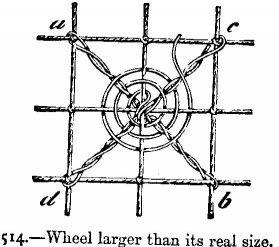
STARS are of various form, as shown in Nos. 516, 517, 518, 519, and 520.
No. 516 is worked in point de feston (see page 507) round a single square hole, which is filled in by a small wheel or rosette.
No. 517 is worked in point de feston and point de Bruxelles, alternately round a centre simply crossed by point d'esprit threads.
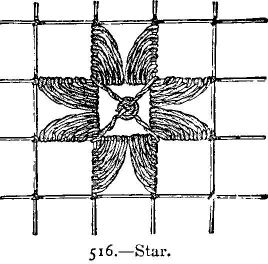
No. 518 is more elaborate, and is worked thus:--Begin at the place marked a; twist the linen thread 3 times round the nearest thread, draw it on to the knot b; repeat this 3 times, following the order of the letters; twist the linen thread also between the threads, as can be seen from the illustration, and fasten it underneath the knot a; for the wheel fasten on the cotton afresh and work the remaining pattern in darning stitch (point de reprise).

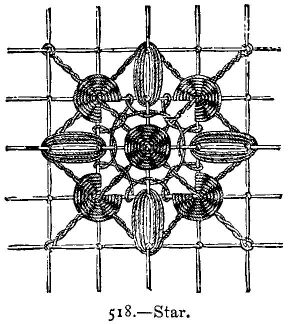
No. 520 consists of a double cross formed by twisted loops of linen thread. Copy these loops exactly from illustration 520.
One part of the straight cross lies underneath, then comes the slanting cross, and lastly, the other part of the straight cross.

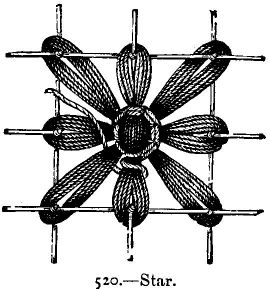
In the centre the loops of linen thread are fastened with two rounds of stitches. (See illustration 520).
OVERCAST STITCH is worked like embroidery overcast, and forms the stems of the flowers and leaves of guipure d'art; it is worked over one or two coarse threads. It is employed in No. 530, and forms the triangles in the centre of the middle squares.
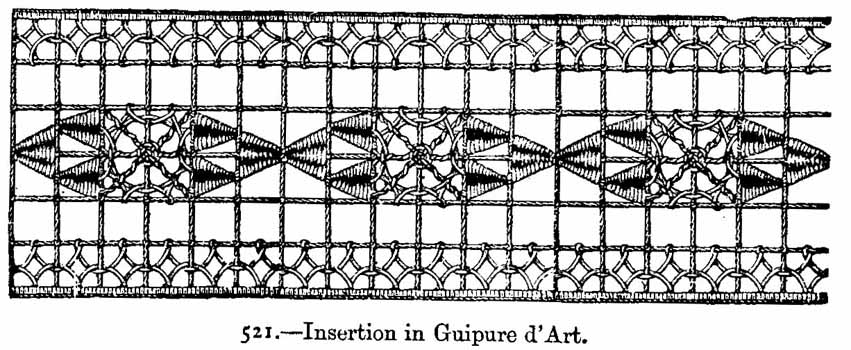
521.--Insertion in Guipure d'Art.
Materials: Guipure frame netting of 6 holes wide; Mecklenburg thread No. 8 or 10; needle No. 7.
For the netted foundation, which is six holes wide, begin at one corner with 2 stitches, work 5 rows, at the end of each of which increase 1 stitch, continue to work the strip with the same number of stitches, alternately decreasing 1 at the end of one row and increasing 1 at the end of the next. For decreasing net 2 stitches together, for increasing net 2 stitches in the same hole. When the strip is sufficiently long, complete it by decreasing in the same proportion as the increasing at the beginning. As the pattern is so clearly shown in the illustration, it will be very easy to work from it. It is worked in point de feston and star wheels; the border is in point d'esprit. The insertion is finished on either side with a row of button-hole stitches.
522.--Lace Border in Guipure D'Art.
Material: Messrs. Walter Evans and Co.'s Mecklenburg thread No. 8 or 10.
This border may be used for various purposes; it makes a pretty edging for toilet cushions if worked in fine thread, and looks equally well for trimming couvrettes, &c., in No. 2 thread. The netting is nine holes wide, the stitches employed are point d'esprit and point de feston, the edge is in buttonhole stitch, the netted ground is cut away outside the scallops.
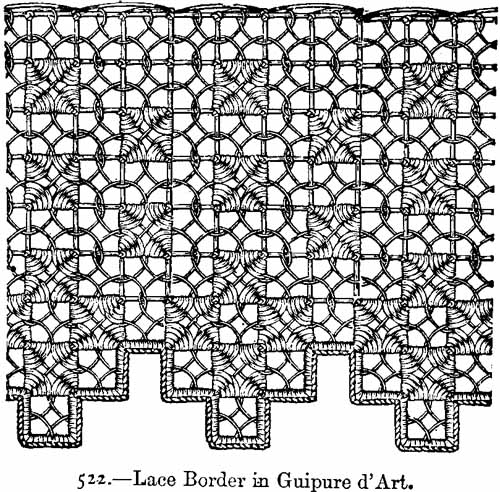
523.--Square for D'Oyley
Materials: Frame; 1 square of netting; Mecklenburg reel thread Nos. 8 and 10; needle No. 6.
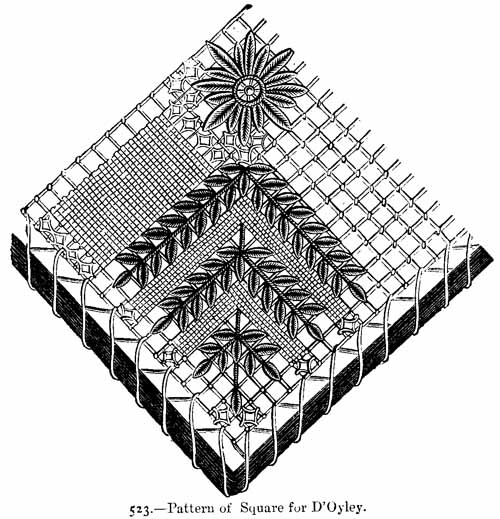
This square may be used to form part of a couvrette, or a d'oyley, or pincushion. The three other corners of the square are worked exactly like the one seen in illustration; the rosette in the centre is shown in full size. The square is worked in point d'esprit, linen stitch, and point de reprise. Each of the leaves of the foliage is worked in one hole of the netting; they are worked by throwing the cotton three times across the hole, and working darning stitch on them. The stem is worked in overcast on the thread of the netting. The daisy in the centre is worked like the leaves, each leaf taking up one or more holes of the netting.
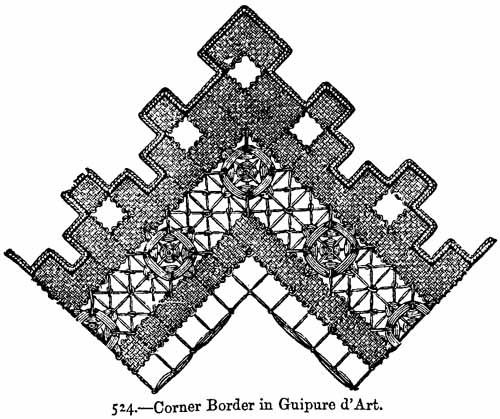
524 and 525.--Corner Borders in Guipure d'Art.
Materials: Messrs. Walter Evans and Co.'s Mecklenburg thread No. 2 for couvrettes, No. 8 for pillow-cases, No. 16 for lace edgings.
These corner borders are suitable for pillow-cases or small couvrettes; the stitches worked on these patterns are linen stitch, darning stitch, point de Bruxelles, and wheels. The edge is formed by buttonhole stitches. The netting is cut away after these are worked.
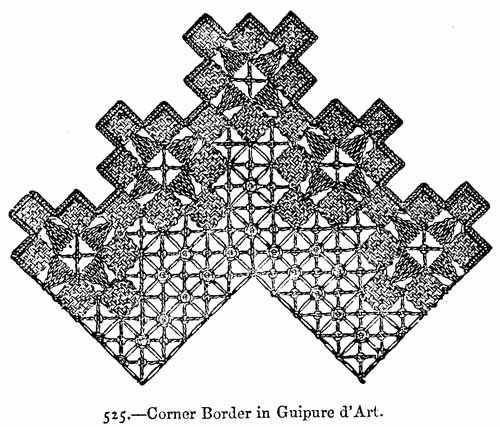
526.--Strip of Insertion in Guipure d'Art.
Material: Messrs. Walter Evans and Co.'s Mecklenburg thread No. 8.
This strip of insertion is 8 stitches wide, and is worked in zigzag lines of point de feston, with a border of point d'esprit and point de toile; a four-point star occupies the centre of the triangle left by the zigzag line. This pattern is so easy to work that it hardly needs description, the only part requiring care being the squares of point de feston; these are begun in the centre, and the thread should be drawn rather tightly so as to form a good square.
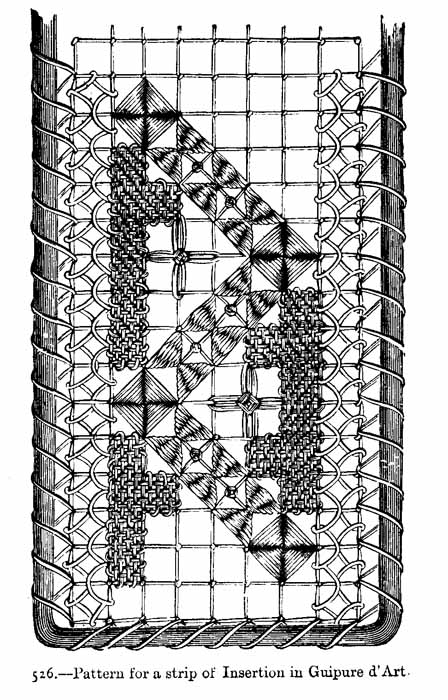
527.--Small Square.
Materials: Frame; Messrs. Walter Evans and Co.'s Mecklenburg thread No. 4, 6, or 8 for the netting, and No. 16 for the pattern.
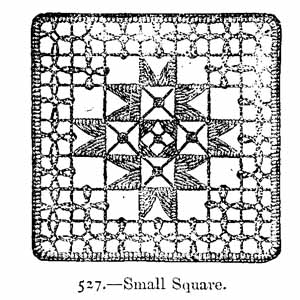
Work over a mesh measuring 2-1/10 inch round the foundation of each square, which has seven stitches in length, and as many in breadth. It is embroidered in darning stitch, and point d'esprit, and wheels. The outer edge is worked round in button-hole stitch. Larger squares are worked in the same manner, only a few rows larger in length and breadth. The squares are fastened together with a few stitches, and sewn on the pincushion or any article they are intended to ornament.
528.--Insertion in Guipure d'Art.
Materials: Messrs. Walter Evans and Co.'s Mecklenburg thread No. 8, or 16 for very fine work.
This strip of insertion is very pretty, and can be used for all kinds of lingeries. The size of the material depends, of course, on the use to be made of the insertion. The guipure pattern is worked in linen stitch and point d'esprit, the raised leaves in darning stitch. The edges are worked round with buttonhole stitches.
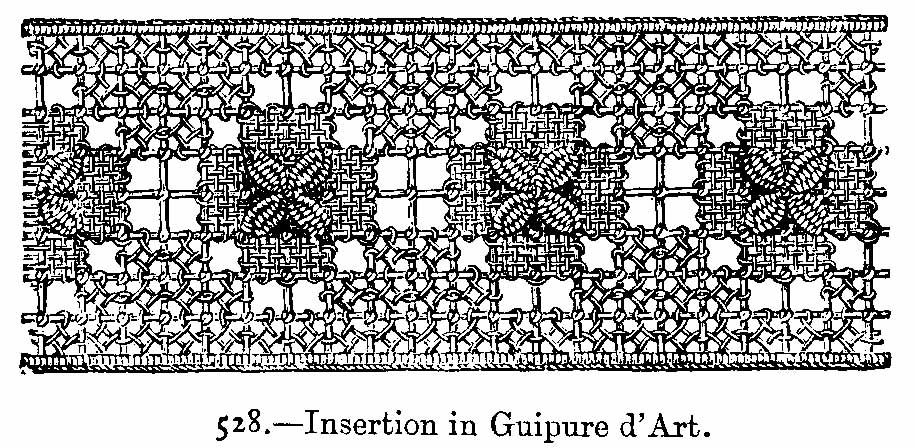
529.--Rosette in Guipure d'Art.
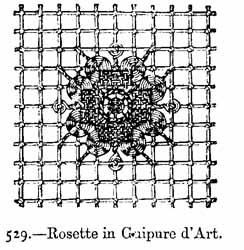
Material: Messrs. Walter Evans and Co.'s Mecklenburg thread No. 6.
This rosette is worked in point de toile and small wheels. A larger wheel occupies the centre, and is ornamented with a round of overcast.
530.--Quarter of a Square in Guipure d'Art.
Materials: One guipure frame; Mecklenburg thread Nos. 6 and 12; needle No. 7.
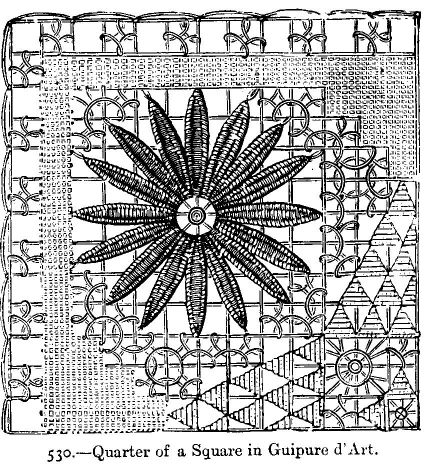
This pattern shows, in full size, one quarter of a square in guipure d'art. The outer border is in point d'esprit, then comes a border in linen stitch. There are large stars in the corners; these stars are worked in raised darning stitch only, and fastened on the netting at the points of each brand; in the centre of the star there is a wheel (see No. 515) edged with buttonhole stitch. The pattern for the centre, one quarter of which only is seen in the illustration, consists of 4 branches forming small triangles in point de Bruxelles, 4 open-worked stars or wheels worked over 4 holes of the netting, and a four-branched centre of point de feston with a wheel in the middle.
531 and 532.--Square Patterns in Guipure d'Art.
Materials: Messrs. Walter Evans and Co.'s linen thread No. 2 for the netting, and their Mecklenburg thread for the guipure stitches No. 8.
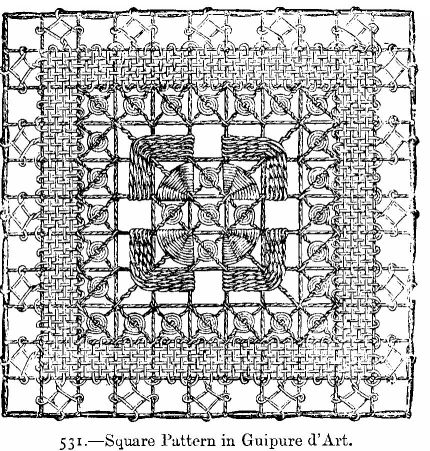
No. 531. The outer border of this pretty square is worked in point d'esprit, the inner border in point de toile; then follows a round of small wheels or rosettes.
For these, fasten the cotton to one of the knots of the first square stitch of this round, work one loop upon each of the three other knots, so as to form a slanting cross; then work round the centre point of the cross, passing alternately under and over its branches, then twist the cotton over the threads of the foundation until the next square is reached, and begin another wheel.
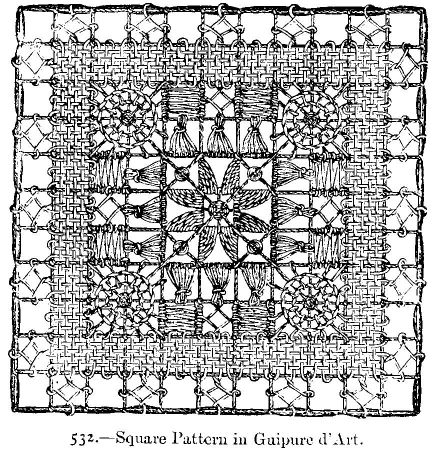
The centre of No. 531 is composed of wheels and point de reprise; the pattern round the centre is worked in point de feston, differing a little from that given on pages 505 and 506, but the illustration clearly shows the difference.
No. 532 has similar borders to No. 531; the centre is occupied by a star (see page 512) in point de feston; four large wheels surround this; the square stitches between are filled with small wheels and with groups of long loops, fastened together in sheaves. Point d'esprit and point de toile, worked one way only, complete this square.
533 to 536.--Four Patterns in Guipure d'Art.
Material: Messrs. Walter Evans and Co.'s Mecklenburg thread No. 2 or 16, according to the size of the work.
These four patterns will be found useful for filling up small squares, or for varying the usual groundwork of point d'esprit.
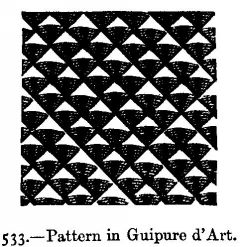
No. 533 is a succession of point de feston stitches, which half fill each square of the netting. This pattern must be worked with great regularity.
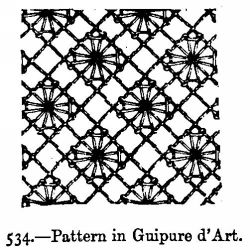
No. 534 consists of a kind of double point d'esprit.
No. 535 is a thread twisted and taken across each square, and resembles lace stitches.
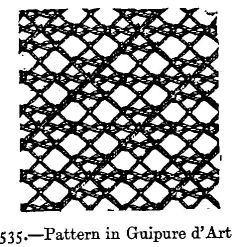
No. 536 is a succession of small close wheels, intermingled with point d'esprit. This grounding is very effective.

537.--Lace Border for Veils, &c.
Materials: Messrs. Walter Evans and Co.'s Mecklenburg thread No. 16; strip of square netting of the required length; oblong frame.
This simple border is easily and quickly worked. The edge is overcast, the ground worked in point d'esprit, the border in point de toile, and the pattern in point de reprise. When completed the netting is cut away from the overcast edge.
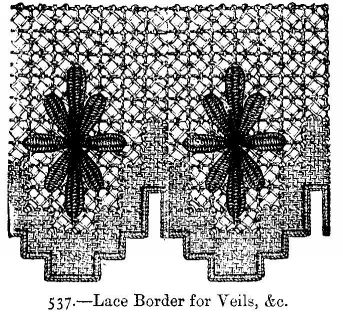
538 and 538a.--Squares in Guipure d'Art.
Materials: 2 squares of netting of 8 holes; Messrs. Walter Evans and Co.'s Mecklenburg thread No. 10 or 16, according to the fineness required.
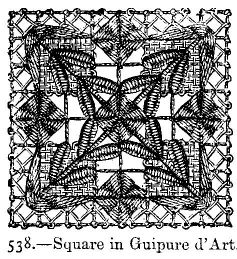
These squares are very pretty for cravat ends, cuffs, or handkerchiefs. They are worked on netting with very fine cotton in the usual manner, beginning on two stitches in one corner The different stitches of the guipure darning can be distinctly seen in illustration, and are point de feston, point de reprise, point de toile, and point d'esprit on No. 538, and the same stitches surround a wheel in No. 538a.
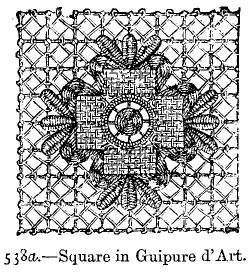
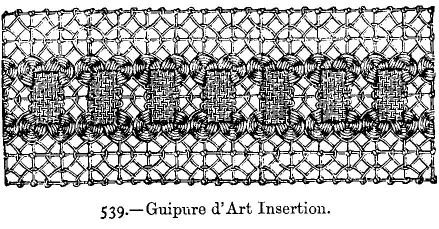
539.--Insertion in Guipure d'Art.
Materials: Messrs. Walter Evans and Co.'s Mecklenburg thread Nos. 8 to 16; strip of netting length, required.
This insertion is worked in point de toile, and wheels worked in point de feston. The ground in point d'esprit.
540 and 541.--Square in Guipure Point de Venise (Reticella)
Materials: Coarse or fine linen; Messrs. Walter Evans and Co.'s Mecklenburg thread No. 4 or 12.
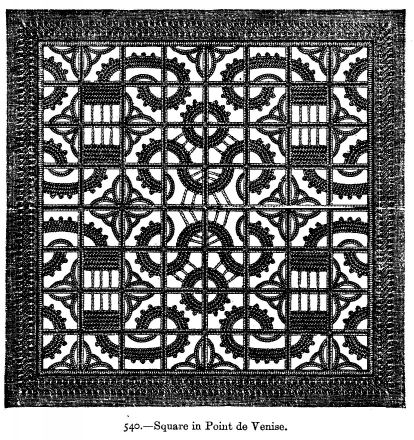

This square is worked in the so-called point de Venise, together with other squares; it is very pretty for covers, toilet cushions, &c. It is worked on coarse or fine linen, according to the use you wish to make of it. Prepare a square piece of linen, by drawing out long and cross threads, so as to form perfect squares. In the pattern No. 540, which is worked on fine linen, 28 threads have been drawn out, both the long and cross way; 8 squares are formed in this way each time that 28 threads have been drawn out; leave 7 or 8 threads of the ground, which form the framework. Then fasten the piece of linen on card-board, and work close button-hole stitch round the inner edge Then work with darning stitch over the long and cross threads of the ground.
From No. 541, which shows the fourth part of the square 4 times larger than full size, it is easy to see how the framework is darned. When the latter is entirely darned, work the patterns in the different squares in button-hole stitch. The circular and serpentine patterns consist of 3 rows of button-hole stitch; the patterns which imitate whole rosettes and half rosettes are worked in rows of button-hole stitch. For each row the thread must be first drawn from one place to the other, as can be seen in illustration, and fastened on the framework. The knots in the last button-hole stitched row are made by working in each stitch when completed, another stitch, and drawing the cotton again through the first completed knot. It is easy, however, to work all the patterns from No. 541. The dotted lines in the right-hand corner show the direction of the patterns which are wanting there. The square is edged all round with an open-work hem, which can also be worked from No. 541.
542 and 543.--Corner Patterns in Guipure d'Art.
Material: Messrs. Walter Evans and Co.'s Mecklenburg thread No. 14.
These patterns are very pretty for cushions, handkerchiefs, &c. The netted ground is to be worked from the corner. Cast on 2 stitches, and work in rows backwards and forwards, increasing 1 stitch at the end of every row. The pattern is worked in point d'esprit, linen, and darning stitch, as can be seen in illustration.
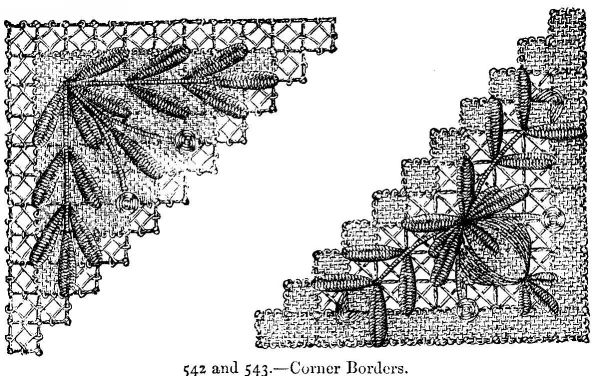
544.--Flower for Ornamenting Cravats and Caps in Guipure d'Art.
Materials: Black or coloured silks, or Messrs. Walter Evans and Co.'s Mecklenburg thread No. 10.
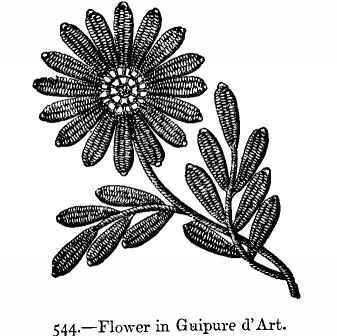
This pattern is worked with middle-sized light-coloured purse silk in guipure d'art on netting. This pattern can also be worked with white thread or black silk in point de reprise.
545.--Work Basket with Covering of Darned Netting.
Materials: Bamboo cane basket; blue satin; cardboard; netting; Messrs. Walter Evans and Co's Mecklenburg thread No. 16.

This elegant basket is made of bamboo cane and blue satin, fastened on cardboard, and covered with guipure d'art. The stand of varnished bamboo is twelve inches long, seven and a half inches wide, and five and a half inches high. The case inside is made of cardboard, covered on both sides with blue satin, and the guipure d'art on the outside only. The stitches used are point de toile, point de reprise, and point d'esprit.
546 and 547.--Squares in Guipure d'Art.
Materials: Messrs. Walter Evans and Co.'s Mecklenburg thread No. 12 or 20; and point d'esprit according to the fineness required.
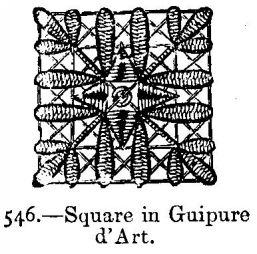
Both these square patterns are suitable for ornamenting lingerie, cravats, collars, &c. Repeated at regular intervals on a larger centre, they are likewise suitable for couvrettes, cushions, pillow-cases, &c.; they are worked in darning and linen stitch.

548.--Insertion in Guipure d'Art.
Materials: Strip of netting 6 holes wide, and of the required length; Messrs. Walter Evans and Co.'s Mecklenburg thread No. 8 or 12.
This simple insertion consists of double rows of wheels worked at each side of a strip of point d'esprit, an edge of buttonhole stitches being worked between the rows.
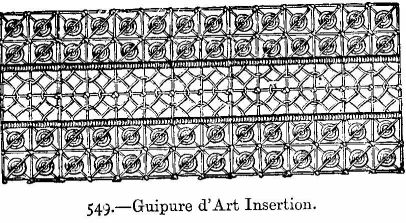
550 and 551.--Squares for Antimacassar.
Materials: Square of netting of 12 holes; Messrs. Walter Evans and Co's Mecklenburg thread No. 8.
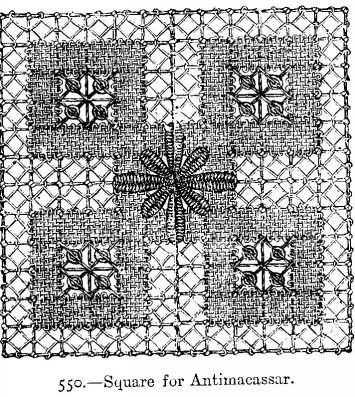
No. 550 is very quickly worked. The border and groundwork in point d'esprit, the centre star in point de reprise, the pattern in point de toile. Wheels fill in the four holes in the centre of the squares.
No. 551 has a border in point d'esprit, the star is worked in point de feston, the other stitches are point de toile. Wheels in part of star pattern No. 518.
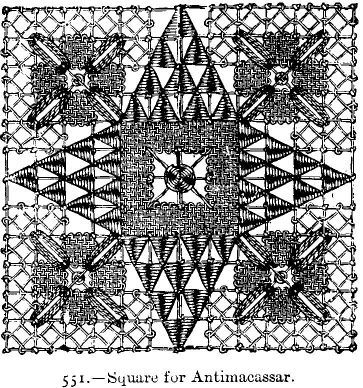
552 and 553.--Borders in Guipure d'Art.
Material: Messrs. Walter Evans and Co.'s Mecklenburg thread No. 8 or 16.
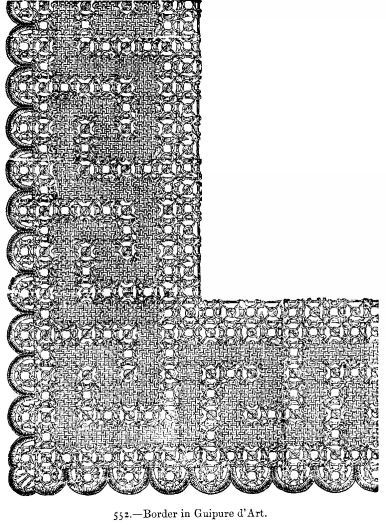
These corner borders are very suitable for couvrettes, and, worked with fine thread, for pocket-handkerchiefs. The netted ground of the borders is to be worked in the size seen in illustration; for the border No. 553 darn the ground in button-hole stitch, darning stitch, point d'esprit, and point de feston; the pattern No. 552 is worked in linen stitch and point d'esprit; small wheels are also to be worked. Both borders are to be worked round in button-hole stitch; the netted ground is cut away along the outside.
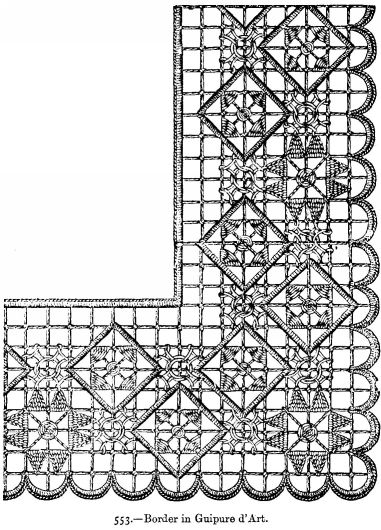
554 and 555.--Squares in Guipure d'Art.
Materials: Messrs. Walter Evans and Co.'s Mecklenburg thread No. 20; netted squares of 7 and 8 holes.

These two small squares are suitable for ornamenting cravats, lappets for caps and lingeries. They are worked in darning and linen stitch. The centre part of the square, No. 554, is a small wheel covered with raised stitches.

556.--Square in Guipure d'Art.
Material: Messrs. Walter Evans and Co.'s Mecklenburg thread No. 12.
The centre of this square is worked in point de feston as well as the border; point de toile forms the groundwork of the square in the centre, round which a row of button-hole stitch is worked.
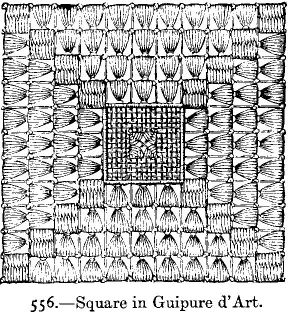
557.--Insertion in Guipure d'Art.
Materials: Strip of netting of 4 holes in width; Messrs. Walter Evans and Co.'s Mecklenburg thread No. 12.
The ground of this simple pattern is worked in point d'esprit, square wheels are worked in the centre of the strip.

558 to 563.--Different Strips of Insertion, Rosettes and Lace, in Guipure d'Art.
Materials: Fine white cotton; Messrs. Waiter Evans and Co.'s Mecklenburg thread Nos. 16 and 20.
These strips of insertion, rosettes, and borders are very suitable for ornamenting lingeries, cravats, &c. The ground of insertion, Nos. 558 and 560, is worked with fine white cotton over a fine steel knitting-needle, in slanting netting, and darned with thread in the manner seen in illustrations. The ground of each strip is 11 rounds wide, and worked with button-hole stitch along the edges; the darned patterns can be worked from illustration.
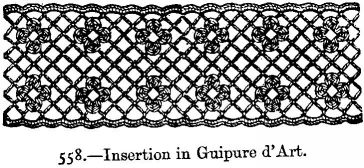

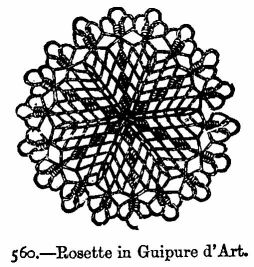
For the rosette, No. 560, cast on 6 stitches over a fine knitting-needle, and join the stitches into a circle; in the 1st round work 2 stitches in every stitch. In the 2nd--5th rounds work 2 stitches in every increased stitch of the preceding round, and in every other stitch 1 stitch. In the 6th round take a steel knitting-needle double the size of the first, and work over it 1 stitch in every stitch of the preceding round. Then work the 7th round over the fine needle as follows:--
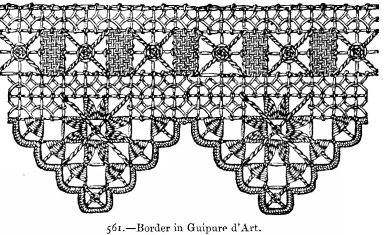
Draw always the second stitch of 2 stitches through the first, and work 1 stitch in the stitch which has been drawn through the first, and then 1 stitch through the other stitch. In the 8th round work always 2 stitches in the stitch between the 2 crossed stitches, 1 stitch in all the other stitches. Lastly, darn the rosette, from illustration, with fine glazed cotton.
For the ground of the rosettes, illustrations Nos. 562 and 563, cast on 6 stitches, join the stitches into a circle, and work then in the 1st round 2 stitches in every stitch; in the following 8 rounds 2 stitches in every increased stitch, in all the other stitches 1 stitch. The last (10th) round is worked without increasing. Then darn the rosettes, from illustrations, with thread in darning stitch, linen stitch, and point d'esprit. The edges of the two rosettes are worked round in button-hole stitch; in every selvedge stitch work 3 button-hole stitches. These two rosettes can be joined together for small couvrettes.
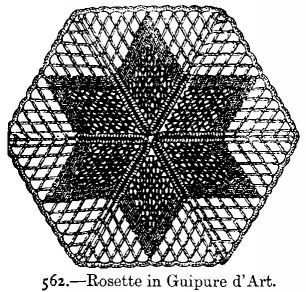
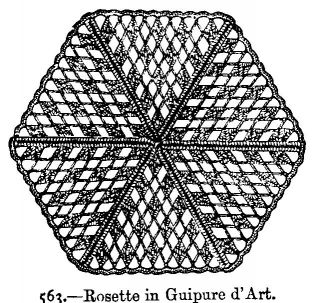
The ground of the border, No. 561, is formed by a strip of straight netting 9 squares wide, cut out in vandykes on one side, and worked round in button-hole stitch, as seen in illustration. This ground is darned, from No. 561, in darning stitch, point d'esprit, linen stitch, and ornamented with bars and wheels (See illustration).

564 and 565.--Corner Borders in Guipure d'Art.
Material: Messrs. Walter Evans and Co.'s Mecklenburg thread No. 20 for handkerchief, or No. 8 for couvrettes.
These corner borders are suitable for handkerchiefs, couvrettes, &c., or as strips of insertion for cushions or pillowcases. They are worked with more or less fine cotton, according to the use they are meant for. They are edged round with button-hole stitch on the outside, and finished off with a row of crochet purl. Work 1 double in every button-hole stitch; after every other stitch draw out the loop on the needle about one-tenth of an inch; take out the needle and leave the loop as a purl; take up 1 loop in last double stitch, and cast it off with the next double stitch.
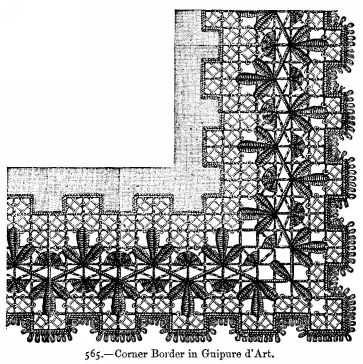
566.--Jewel Case, forming Pincushion.
Materials: Deal box; satin ruche; satin ribbon; quilted satin and silk cord; guipure netting.
This case consists of a square cardboard or deal box, lined with satin, and slightly quilted; it is also covered on the top with satin, and ornamented all round with a satin ruche four-fifths of an inch wide, pleated in the manner seen in illustration. The top of the box is stuffed so as to form a pincushion. It is then covered with guipure d'art No. 567. Ornament all round with silk cords, and at the corners with bows of satin ribbon.
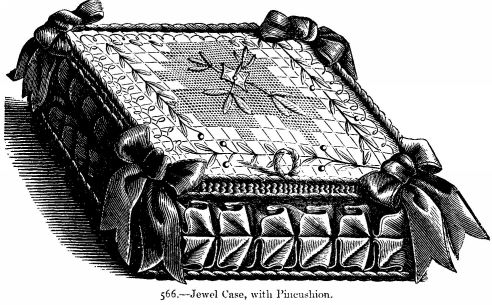
567.--Guipure Pattern for Jewel Case.
Materials: Netting 25 holes square; Messrs. Walter Evans and Co.'s Mecklenburg thread No. 14.
This cover is worked in point d'esprit, point de toile, point de reprise, and point de feston. Thick dots are introduced occasionally.
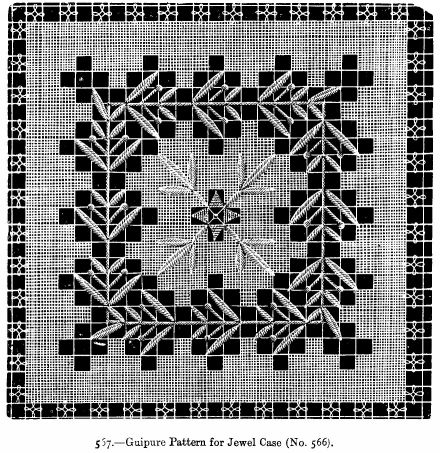
568.--Parasol Cover in Guipure d'Art.
Materials: Messrs. Walter Evans and Co.'s Mecklenburg thread No. 20, and cotton No. 80.
For working this cover, one part of which is shown in our illustration two-thirds of its full size, work first a straight strip of netting for the foundation, which must count as many holes in width as are required for the width of the covering. The size of the holes depends on the size of the knitting-needle or mesh which you use. The pattern is worked with cotton No. 80, over a steel knitting-needle which measures two-fifths of an inch round. Begin the strip in one corner. Cast on 2 stitches, and work in rows backwards and forwards, increasing 1 stitch at the end of every row, till you have 1 stitch more than the stripe is to have holes in width, on our pattern 68 stitches; then work 1 row on the same number of stitches, and then increase alternately 1 stitch at the end of 1 row, and decrease 1 at the end of the next, till the strip is 250 stitches long. The strip is finished off in a straight line at the bottom by working a certain number of rows in which the last stitch remains untouched. At the beginning of the row do not work 1 stitch ever the mesh, but only 1 knot in the stitch of the preceding row, so that the cotton is drawn on tight. When the strip is completed, trace from No. 568 the outlines for the pattern of each of the eight parts of the parasol with double thread, in such a manner that two parts lie next to each other, but reversed, that is, the point of one part must lie next to the wide part of the next part. Then work in each part the pattern seen in illustration, and afterwards each part round with button-hole stitch, working over the double outline. Cut out the different parts, and sew them together on the wrong side with close overcast stitch.

569.--Scent Sachet in Guipure d'Art.
Materials: Messrs. Walter Evans and Co.'s Mecklenburg thread No. 18; green satin; poudre d'iris; green satin ribbon; green silk cord.
The size of the netting depends on that of the sachet. The netting must be fastened in a frame, and darned with fine thread; the flowers are worked in darning stitch, and the ground in point d'esprit. The cushion is made of green satin, perfumed with poudre d'iris. When the netting has been fastened on, it is edged all round with a green satin ruche, and green silk cord, forming loops at every corner.
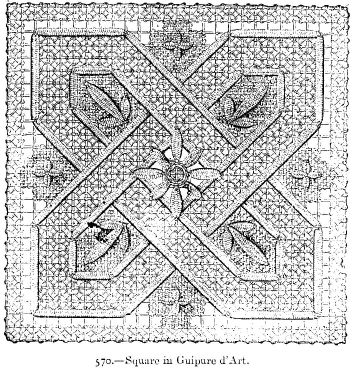
570.--Square in Guipure d'Art.
Materials: Netted square of 26 stitches; Messrs. Walter Evans and Co.'s Mecklenburg thread No. 12.
This pattern is worked in point d'esprit, edged with an outline of point de reprise. This outline may be worked in close button-hole stitch. Point de toile is used for the groundwork, upon which point de reprise is worked.
571 and 572.--Work Case in Guipure d'Art.
Materials: Blue satin; Messrs. Walter Evans and Co.'s Mecklenburg thread No. 16; blue silk cord.
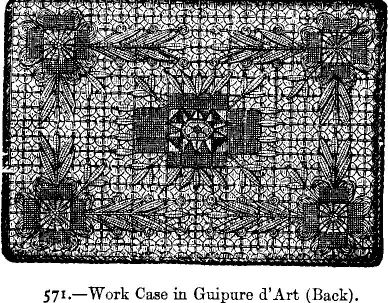
This little work-case, of darned netting and blue satin, is five inches and four-fifths long, four inches wide, and is fastened with a loop and button. The back, front, side, and the flap are worked all in one piece. The netting is worked with white thread No. 12, over a mesh measuring at least two-fifths of an inch round. For the flap the netting must be slanted off on both sides; this is done either by decreasings, or by cutting off the corners of the work. The latter is then darned in linen stitch, darning stitch, and point d'esprit, from No. 572, which shows the front of the case, and from No. 571, which shows the back. The netting is then lined with blue satin, and sewn together at the sides with button-hole stitches on the right side. The flap is edged with button-hole stitch; sew on a small button, and make a small loop to correspond. The case is edged all round with blue silk cord.
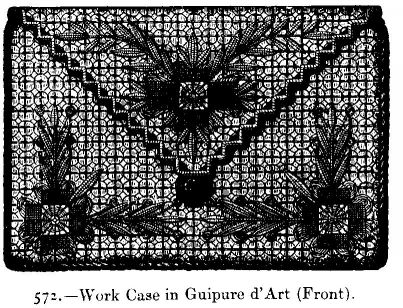
573.--Banner Screen in Guipure d'Art.
Materials: Netting; Messrs. Walter Evans and Co.'s Mecklenburg thread No. 12; carved oak stand; glacé silk; cords; tassels.
Banner-screens are used in two ways, either suspended from the mantelpiece or mounted as shown in illustration No. 573. The banner is 23 inches long, 19 inches wide, lined with coloured glacé silk, and edged with a lace border of guipure d'art. The design for the banner is given in page 554. Work the netting for the groundwork over a larger or smaller mesh, according to the size you wish it to be. The pattern is worked in point d'esprit, point de reprise, and point de toile. When the pattern is completed, line the banner with coloured silk, edge with a gathered border of guipure d'art, finish with coloured silk cords and tassels. The banner may be finished off in close button-hole stitch, instead of adding the lace border.
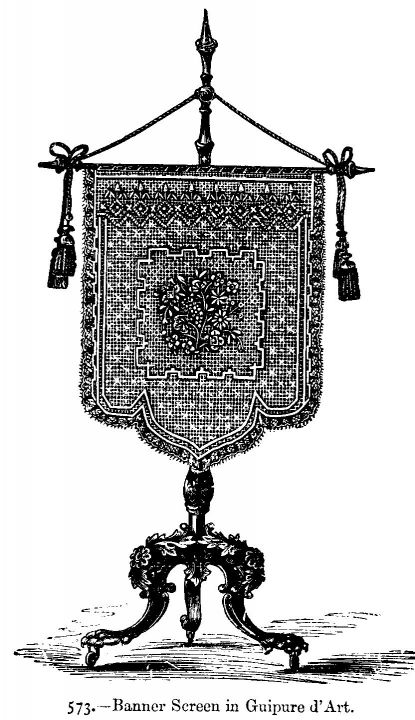

575.--Border in Guipure d'Art.
Material: Messrs. Walter Evans and Co.'s Mecklenburg thread No. 8.
This border is suited for couvrettes. It is worked in point d'esprit, point de reprise, or plain darning stitch, edged by a row of button-hole, and finished with a crochet edging.
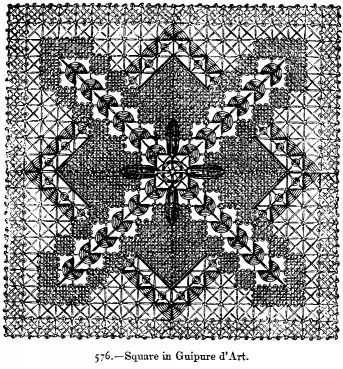
576.--Square in Guipure d'Art.
Materials: Messrs. Walter Evans and Co.'s Mecklenburg thread No. 12; netted square of 20 holes.
This pretty square is worked in a pattern formed by point de feston, point de toile, and point de reprise, the star in the centre as that shown on page 514, omitting the alternate points; border of point d'esprit, ground worked in simple crossed bars. Table of the right size of Mecklenburg thread to use in working:--
| NO. | |
|---|---|
| Antimacassars | 2 |
| Borders | 4 |
| Handkerchiefs | 20 |
| Insertions | 8 |
| Lace edgings and insertions | 16 |
| Lamp shades | 16 |
| Parasol covers | 18 |
| Sachets | 12 |
| Sofa cushions | 8 |
| Toilet cushions | 10 |
| Toilet mats | 10 |
FRAMES
May be obtained for large, middle-size, and small squares.
Oblong frames are used for working insertions and lace edgings.
| Pattern Categories Browse the categories to help you find the patterns you're looking for. |
||







